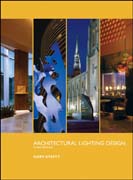
Lighting design is the art and science of lighting interior and exterior spaces. Successful architectural lighting design enhances the built environment through the integration of light and space and includes evaluating the needs of the occupants and the space, establishing lighting criteria, researching and specifying lighting fixtures, and documenting lighting solutions. ArchitecturalLighting Design, Third Edition provides an thorough overview of lighting design and the process for designing lighting. Qualitative and quantitative issuesare outlined and design techniques and lighting hardware technologies are reviewed. Guidance on criteria development, concept development and design development remain a cornerstone of the book. This accessible book balances the art and science of lighting design. INDICE: Preface. Acknowledgements. Chapter 1: Background. Conventions. Defining the Problem- Its About Vision. The Industry. Organizations. Codes, Standards, and Legislative Actions. Certification- the NCQLP. Education. ContinuingEducation. Publications. The Internet. Endnotes. Chapter 2: The Problem. Physiology. The Eye. Color Vision. Adaptation. Accommodation. Aging. Astigmatism. Seasonal Affective Disorded (SAD). Circadian Rhythym. Psychology. Endnotes. References. Chapter 3: Project Scope. Project Specifics. Programming. Design Strategies. Schematic Design. Design Development. Contract Documents. Construction Administration. Chapter 4: Design Goals. Inventorying Conditions. Spatial Factors. Systems Factors. Psychological and Physiological Factors. Task Factors.Programming Statements. Endnotes. References. Chapter 5: Spatial Factors. Pleasantness. Spatial Definition. Spatial Order. Circulation. Endnotes. Project Data. Chapter 6: Criteria- System Factors. Flexibilitiy. Controls. Acoustics. HVAC. Ceiling Systems. Codes. Ordinances. Sustainability. Certification. Maintenance. Endnotes. References. Chapter 7: Criteria- Psychological and Physiological Factors. Sensory Responses. Hierarchies and Focals. Subjective Impressions. Color. Daylighting. Night Lighting. Health. Endnotes. References. Chapter 8:Criteria- Task Factors. Visual Tasks. Luminances. Reflectances. Tansmittances. Interior Illuminances. Exterior Illuminances. Targets. Endnotes. References.Chapter 9: Daylighting. Benefits. Design Aspects. Design Practice. Technologies. Color. Controls. Maintenance. Modeling. Endnotes. Chapter 10: Lamps. Lamp Families. Filament. Cold Cathode. Fluorescent. Electrodeless. LED. Mixing Lamps. Future. Caveats. Endnotes. References. Project Data. Chapter 11: Luminaires. Hardware. Construction. Appearance. Photometry. Literature. Specific Types. Custom. Details. Exterior. References. Chapter 12: Controls. On/off Switches. Dimmers. Networks. Presets. Timeclocks. Motion Sensors. Photocells. Strategies. Styles/ Layout. References. Chapter 13: Design Tools. Qualitative Design Tools. Quantitative Design Tools. Endnotes. Chapter 14: Construction. RCPs. Details. Specifications. Cutsheets. Review. Bids. Client. Knowledge. Designers Role. Lighting Reps. DN Budget. VE. Shop Drawings. Assistance. Review. Commissioning. Post Occupancy. Endnotes.
- ISBN: 978-0-470-11249-6
- Editorial: John Wiley & Sons
- Encuadernacion: Cartoné
- Páginas: 368
- Fecha Publicación: 17/07/2008
- Nº Volúmenes: 1
- Idioma: Inglés
